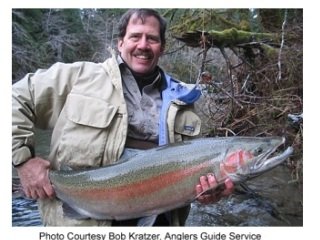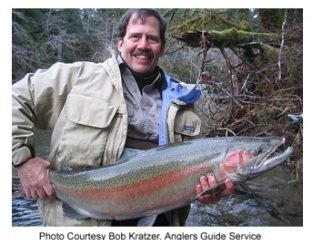 If you’ve been a loyal follower of this site, then I’m sure you’ll recall an article I wrote a while back in which I touched upon the river fishing scene in a small area of Indiana. In that article, I briefly described steelhead fishing techniques utilized by local anglers in the area. However, since steelheading is such a popular activity and with the colder months now pretty consistent in major steelheading areas, I felt that a more in-depth description of the techniques, tackle, and locations that steelhead fishing entails was in order.
If you’ve been a loyal follower of this site, then I’m sure you’ll recall an article I wrote a while back in which I touched upon the river fishing scene in a small area of Indiana. In that article, I briefly described steelhead fishing techniques utilized by local anglers in the area. However, since steelheading is such a popular activity and with the colder months now pretty consistent in major steelheading areas, I felt that a more in-depth description of the techniques, tackle, and locations that steelhead fishing entails was in order.
From late autumn and throughout the winter, the river is where you’ll want to be for amazing steelhead action. If there are any rivers in your area, odds are you’ll find steelhead there this time of year, especially in the Midwest, and float fishing for them is an exciting experience that every angler should try out during the time of year when the majority of popular game species are inaccessible. How knowledgeable you are regarding your local river systems, especially when it comes to the deeper holes, will ultimately determine your style, but the technique for float fishing will remain unchanged for the most part. The rig is very simple, and is set up as follows: slip float, followed by a few small split shots, and then your small hook rigged with whatever steelhead bait you choose.
You’ll want to use a longer, lighter action rod for float fishing. St. Croix makes steelhead rods that are available in their Avid series, as well as their specially designed Wild River series. Anglers looking to save some money, however, can also pick up one of Browning’s Six Rivers rods, or even a longer Microlite rod, which is made by Bass Pro Shops. The longer rods allow you to keep the line running through the center of the river, which reduces the pull on your bait. The lighter action also keeps you from putting too much pressure on your hook while fighting your fish, which enables you to wear the fish out, while keeping a solid hook set.
For line, any strong monofilament will do, but my personal favorite for steelheading is P-Line’s CXX, which is a super strong and abrasion-resistant line that will withstand everything from long runs to logs and other structure. Hooks are an easy decision as well, as Owner’s smaller mosquito hooks are a great choice. Redwing Tackle’s Phantom Blackbird floats are a popular choice for steelheaders, due to their clear plastic design that is invisible beneath the water, but a high-vis top that you’ll be able to see clearly above the water. Last, but not least, is the bait, of which you have a few choices. Small, pre-cooked salad shrimp, found in any grocery store and coated in non-iodized salt, is an effective and cheap option. Spawn sacs and skein work very well also, though their use is prohibited in certain states, so be sure to check the regulations in your area.
Experiment with different depths while on the river to see where the fish are striking and be patient. Try a spot for a half hour or so and then move downriver to a new location if you don’t get a bite. The key is to find bottom first and then move your float shallower, little by little. Look for deep holes where steelhead like to situate. Check with local bait shops and search online for good access points, as they are more often than not hard to find. Enjoy yourself, most importantly, and be very careful; swimming is a fun pastime, but falling into a river in winter is very dangerous. Until you learn the river a little better, fish from shore. I wish you all good luck and if you’re from the Southeast Michigan area, I may see you on the Huron River this winter.








